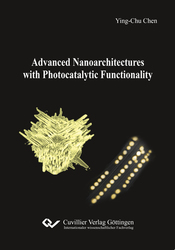| Areas | |
|---|---|
| Serie de libros (96) |
1378
|
| Nachhaltigkeit |
3
|
| Gesundheitswesen |
1
|
| Letra |
2364
|
| Ciencias Naturales |
5406
|
| Matemática | 229 |
| Informática | 319 |
| Física | 980 |
| Química | 1363 |
| Geociencias | 131 |
| Medicina humana | 243 |
| Estomatología | 10 |
| Veterinaria | 108 |
| Farmacia | 147 |
| Biología | 835 |
| Bioquímica, biología molecular, tecnología genética | 121 |
| Biofísica | 25 |
| Nutrición | 45 |
| Agricultura | 1004 |
| Silvicultura | 201 |
| Horticultura | 20 |
| Ecología y conservación de la tierra | 148 |
| Ciencias Ingeniería |
1793
|
| General |
98
|
|
Leitlinien Unfallchirurgie
5. Auflage bestellen |
|
Erweiterte Suche
Advanced Nanoarchitectures with Photocatalytic Functionality (Tienda española)
Ying-Chu Chen (Autor)Previo
Lectura de prueba, PDF (830 KB)
Indice, PDF (50 KB)
Two novel nanoarchitectures – including the highly branched spikecube exemplified by β-SnWO4 and the biomimetic nanopeapod manifested in Au@Nb@HxK1-xNbO3 – were put forward for the first time in this dissertation, particularly aiming at enriching the library of pattern designs for sunlight-driven photo(electro)chemical applications. Specifically, β-SnWO4 spikecubes were entitled on the basis of the peculiar morphology, wherein bundles of nanopillars were self-aligned with quasi-periodicity onto each sharp face of hexahedral cube cores. Moreover, this geometric engineering was particularly carried out on a Scheelite-type (ABO4) β-SnWO4 crystal with a visible-light-active band gap of 2.91 eV and subtle conduction and valence band positions, endowing the photoexcited electron-hole pairs on β-SnWO4 with strong reducing and oxidizing power, respectively. Consequently, an outstanding photocatalytic activity in degrading organic dyes was observed for the β-SnWO4 spikecube with an enhancement more than 150% in comparison with a benchmark visible-light-active WO3 photocatalyst. By contrast, the design of Au@Nb@HxK1-xNbO3 emulates the growth pattern of a natural plant – a peapod –, wherein sub-10 nm core-shell Au@Nb plasmonic bimetallics as the particulate peas seeded discretely inside the unidirectional cavity of the tubular HxK1-xNbO3 semiconductor as the pod. The biomimicry of this configuration endows the Au@Nb@HxK1-xNbO3 nanopeapods with strong light harvesting abilities, wherein the HxK1-xNbO3 nanopod and the Au@Nb nanopeas absorb ultraviolet and visible light via interband transition and surface plasmon resonance, respectively. More importantly, the strong near-field plasmon-plasmon coupling between neighboured Au@Nb nanoparticles allows the Au@Nb@HxK1-xNbO3 nanopeapod absorbing near-infrared light. Last but not least, dye photodegradation and water photoelectrolysis as proofs-of-concept manifested the full-spectrum utilization of diffusive solar energy by the Au@Nb@HxK1-xNbO3 nanopeapod for environmental remediation and fuel generation, respectively.
| ISBN-13 (Impresion) | 9783736997806 |
| ISBN-13 (E-Book) | 9783736987807 |
| Formato | A5 |
| Idioma | Inglés |
| Numero de paginas | 166 |
| Laminacion de la cubierta | Brillante |
| Edicion | 1. |
| Lugar de publicacion | Göttingen |
| Lugar de la disertacion | Karlsruhe |
| Fecha de publicacion | 23.04.2018 |
| Clasificacion simple | Tesis doctoral |
| Area |
Química
Química inorgánica |
| Palabras claves | spikecube, nanopeapod, photocatalyst, dye photodegradation, water photoelectrolysis |








